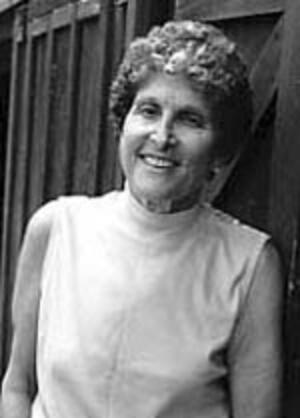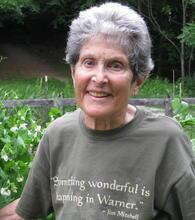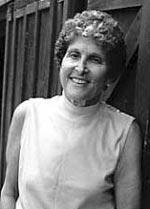Maxine Kumin
Most widely known as a nature poet, Maxine Kumin won the Pulitzer Prize for Up Country with its well-crafted descriptions of life on her New Hampshire farm. Yet increasingly her social conscience prompted her also to write “poetry of witness,” protesting war and torture. Though not a believer, she possessed what she called a “Jewish consciousness,” which showed itself in poems describing being an outsider in a convent school, telling the story of ancestors as the only Jews in a small southern town, and revealing injustices like Grant’s “Jew Order.” A unique blend were poems combining Jewish sacred texts and environmental protest. Whatever their subject, Kumin’s poems were not polemic but artistic, full of figurative language and written in distinctive formats like sonnets and villanelles.
“Writers are all secret Jews,” declared poet and writer Maxine Kumin in a Massachusetts Review interview in 1975, two years after receiving the Pulitzer Prize for Up Country: Poems of New England. This statement is particularly significant for what it implies about Kumin’s Jewish background and the role it has played in her work—a role frequently overlooked by readers and critics. Because much of her subtle, elegantly crafted poetry focuses on the details of country living (gardening, mushrooming, horse raising, coping with wild animals, experiencing the change of seasons), it is frequently classified as pastoral. Kumin has been compared to Robert Frost, an association that pleased her. She has also been considered a confessional poet, in the manner of her friend and colleague Anne Sexton. These descriptions, though not inaccurate, are limited. For Kumin was also a Jewish American woman poet whose writing closely examined what it means to negotiate the demands of two different cultures. Her work constantly questioned and expanded the concept of Jewishness in contemporary, culturally divided America.
Family and Education
Born Maxine Winokur on June 6, 1925, in Germantown, a well-to-do suburb of Philadelphia, Pennsylvania, she was the youngest of four children and the only girl. Her father, Peter Winokur, was a successful pawnbroker whose family had emigrated from Eastern Europe. Her mother, Doll (Simon), whose family emigrated from Bohemia to Virginia in the nineteenth century, had wanted to become a professional musician, an ambition thwarted by her father. Similarly, Maxine, an excellent swimmer, was prevented from joining Bill Rose’s Aquacade by her father. Peter Winokur, however, did approve of her writing. As a “Jewish patriarch,” he respected the written word.
As a child, Kumin attended the convent school run by the Sisters of St. Joseph next door to her home for three years; later, she attended secular Philadelphia schools. She received her B.A. in history and literature from Radcliffe College in 1946. Soon after graduation, she married Victor Montwid Kumin, an engineer, with whom she had three children: Jane Simon, Judith Montwid, and Daniel David. She returned to Radcliffe for a master’s degree in 1948.
Becoming a Writer
Participating in a workshop conducted by the poet John Holmes at the Boston Center for Adult Education proved to be extremely beneficial in Kumin’s own development as a poet. At the time, however, getting published presented a challenge. “Until the Women’s Movement,” Kumin said, “it was commonplace to be told by an editor that he’d like to publish more of my poems, but he’d already published one by a woman that month.” Such obstacles notwithstanding, Kumin’s first book of poetry Halfway was published in 1961.
Kumin subsequently published seventeen additional books of poetry; taught poetry writing at Tufts, Washington, Columbia, Brandeis, and Princeton Universities; received the Pulitzer Prize (1973) and the American Academy and Institute of Arts and Letters Award (1980); served as a consultant in poetry to the Library of Congress (1981–1982); and was elected chancellor in the Academy of American Poets (1996). She resigned from the Academy in 1998 to protest the absence of blacks and other minorities on the board of chancellors. Kumin also published five novels, three collections of essays, two books of short stories, numerous children’s books (four with Anne Sexton), and two memoirs.
Jewish Themes
While her fiction reflected Jewish concerns, it is in Kumin’s poetry that such themes were most thoroughly explored. Kumin’s earliest relationships with gentiles initiated a dialogue between cultures that recurred throughout her poetry. In an early poem, “Mother Rosarine,” the poet expressed both the attractions of the convent world, from which the child-speaker steals a rosary, and a sense of alienation from it: “Wrong, born wrong for the convent games.” In “The Spell,” Kumin’s Jewish mother has apparent power in the garden that borders the convent’s yard. Perhaps the most powerful expression of Kumin’s ambivalence toward both cultures occurs in “Sisyphus.” In terse couplets, another child-speaker tells of helping a man in a wheelchair. When he praises her as “a perfect Christian child,” she wishes to contradict him, to assert her Jewishness, but cannot do so. This failure becomes her burden.
In a series of “tribal poems,” Kumin explored her family, its history, and its stories. “The Pawnbroker” is a moving tribute to her father, written after his death. “The Chain” evokes her mother’s life as a Jew in a small Virginia town and connects her parent to a “chain” of mothers and daughters. “Sperm” wittily traces the histories of seventeen cousins. “For My Great-Grandfather: A Message Long Overdue” describes her mother’s ancestor, a tailor from Bohemia, who has moved to Newport News, Virginia. In his new surroundings, he writes letters to his family, ending in blessings, on the backs of bills-of-sale.
Kumin moved from the personal sphere to a wider historical context in another group of poems. In “The Order of History,” the speaker dreams of a pogrom in which her Polish lover would be her enemy, not her ally. She raised the subject of one’s role, whether chosen or not, in the horrifying events of the twentieth century in “The Amsterdam Poem”: The speaker visits Anne Frank’s house, expresses guilt at having been safe in Pennsylvania while other Jews were murdered, and concludes, “for suffering there is no quantum.” In “Woodchucks,” the speaker compares her own escalating determination to exterminate the garden pests to the Nazis’ mad social Darwinism. Violence against a demonized enemy, the poet implies, is regrettably a universal human trait.
In two later poems, the cultural dialogue takes another turn. “Living Alone with Jesus,” written while Kumin was teaching in Danville, Kentucky, begins in a state of alienation and ends with a whimsical act of cross-religious communication. At first, the speaker appears overwhelmed by the “thirty-seven churches” and the hymns flooding her room. Then she imagines Jesus as a guest to whom she offers grapefruit with honey. Kumin shows that in the realm of imagination, religious and cultural differences can be bridged. In “For a Young Nun at Breadloaf,” the religious-cultural divide is resolved in human terms. The engaging Sister Elizabeth asserts that the speaker is, like herself, doing “Christ’s work,” but the speaker calls herself an “Old Jew.” In this poem, the tongue-tied, confused girl of “Sisyphus” has become an adult, well able to manage complicated issues of identity.
Several unique Jewish poems in the section “Turn it, turn it,” in Kumin’s 2007 collection consist of a blend of family memories, pieces of sacred texts, and environmental protest. Having attended years of Sunday school and grown up in a Sabbath-observing home, Kumin had absorbed the Sabbath blessings and stories from Genesis and worked them into her poems. To those elements she added concern about the environment. Use of religious texts makes her environmental message even more serious.
Two strands of Kumin’s Jewish poems are represented in her final collection, And Short the Season (2014). “Purim and the Beetles of Our Lady,” like the 2007 poems, is a mix, but a playful one, of Jewish elements: a Jewish holiday, her father’s use of Yiddish, nature (the beetles), and word play. “Radford VA, 1904” presents, as Kumin did in earlier collections, a piece of family history. Stimulated by an old photograph of her uncles on a horse, she revisits in this poem the small, provincial town where her mother grew up and where her grandfather was recognized as “the Jew.” In this final collection, she wanted to memorialize her heritage one last time.
In her work, Kumin affirmed her Jewish past in “a nation losing its memory,” and extended that past forward to encompass a wider cultural family. In doing so, she left her mark, deftly and sensitively, as an important contemporary Jewish American poet.
Kumin’s life changed drastically in 1998 when her horse, Deuter, bolted at a carriage-driving clinic. Kumin, who was driving, was seriously injured: eleven ribs and the vertebrae at the top of her spinal column were broken, her lung was punctured, her kidney and liver were bruised, and she lost feeling in all four limbs. The diagnosis was not encouraging. However, Kumin experienced a remarkable, even miraculous, recovery, aided by her family (especially her daughter), her love of language (she initially responded to subtitles on the hospital television screen), and the “halo”—a form of axial traction attached to a cage-like vest, in which the head is fastened by four pins. Inside the Halo: The Anatomy of a Recovery (2001) is a clear-sighted and moving account of this experience.
Social Justice Themes
The importance of social justice was always an element in the poems of Maxine Kumin. In her first book, Halfway (1961), the poem “Eleventh Century Doors,” describes a museum piece of bronze doors, depicting Jesus on the cross, which stimulated her to think of cruelties perpetrated throughout history to Jews and others in his name. For the most part, however, Kumin preferred to compose pastoral poems about her New Hampshire farm and said she felt uncomfortable about writing polemic poetry (Hammond 55).
Yet, by the year 2000 she had made a switch, as she observed in her essay “Metamorphosis”: “I feel that my work has truly metamorphosed into the poetry of witness” (117). Indeed, Kumin’s poetry collections of the late twentieth and early twenty-first centuries chronicled some of the worst injustices of these decades: civil wars in Africa (2002), the effects of Patriot Act (2005), the torture of prisoners during Iraq War (2007), and abuses at Guantanamo (2014). At the same time, the poems in these collections, far from being diatribes, are skillfully written, full of poetic devices and written in formal patterns, like villanelles and sonnets. Kumin explained, “[T]he more psychically difficult . . . the poem is to write, the more likely I am to choose a difficult pattern to pound it into . . . . [T]he difficulty frees me to be more honest and more direct” (Hammond 50).
More didactic in tone but still conveying a social justice message are two poems that reveal little-known events in Jewish history. The “The Jew Order” (2005) was stimulated by the poet’s viewing in a museum the document, issued by Ulysses Grant, that expelled Jews from the territory under his command. “I was just totally taken aback,” said Kumin, both by the blatant discrimination of the document and by the fact that it was so unknown (interview with Lois Rubin, 2005). And so, Kumin created a poetic scenario around the proclamation, which ends with Abraham Lincoln’s rescinding the order in the same month that he issued the Emancipation Proclamation.
Stimulated by a Hamas election victory that was threatening to Israel, the poet explores in “Revisionist History: Uganda Program” (2007) an early proposed solution to the troubles of the Jewish people, a homeland to be established in Uganda. In the poetic fantasy she creates, Jews accept Uganda as their homeland and live harmoniously with native Ugandans. In these two poems dealing with challenging historical situations, Kumin is able to extract a positive social message.
Final Writings
In declining health in the final year and a half of her life, Kumin seemed determined to publish as much as she could. In 2014, the year of her death, several works appeared: the poetry collection And Short the Season, “The Making of Pobiz Farm,” published in The American Scholar, and “Metamorphosis from Light Verse to the Poetry of Witness,” published in the collection A Story larger than my Own: Women Writers Look Back on their Lives and Careers. A year later, in 2015, a memoir, The Pawnbroker’s Daughter, containing the two essays above and two others, was published posthumously.
In her 2010 essay “Identity” in the collection The Roots of Things, Kumin described her Jewish identity in this way: “I am a nonbelieving Jew with a strongly developed Jewish consciousness” (30). That Jewish consciousness is on full display in the blend of family memories, social action and sacred text that distinguish her Jewish poems. “In the early years,” Kumin once told an interviewer, “‘you write like a man’ was the supreme compliment.” But for Maxine Kumin, “you write like a Jewish woman” is the highest praise of all.
Selected Works by Maxine Kumin
The Pawnbroker’s Daughter: A Memoir. W. W. Norton & Company, 2015.
And Short the Season. New York: W. W. Norton & Company, 2014.
“Metamorphosis: From Light Verse to the Poetry of Witness. In A Story Larger than My Own: Women Writers Look Back on their Lives and Careers, ed. Janet Burroway. 104-118. Chicago: The University of Chicago Press, 2014.
“Identity.” In The Roots of Things: Essays, ed. Maxine Kumin. 28-31. Evanston, Illinois: Northwestern University Press, 2010.
Still to Mow. New York: W. W. Norton & Company, 2007.
Jack and Other Poems. New York: W. W. Norton & Company, 2005.
The Long Marriage. New York: W.W. Norton & Company, 2001.
Inside the Halo and Beyond: The Anatomy of a Recovery. New York: W.W. Norton & Company, 2000).
Always Beginning. Port Townsend, WA: Copper Canyon Press, 2000. New York: W.W. Norton & Company, 1997.
Connecting the Dots: Poems. New York: W.W. Norton & Company, 1996.
Women, Animals and Vegetables. New York: W.W. Norton & Company, 1996.
Looking for Luck: Poems. New York: Norton, 1992.
In Deep: Country Essays. New York: Viking Penguin, 1987.
The Long Approach. New York: Viking, 1985.
The Microscope. New York: Harper & Row, 1984.
Our Ground Time Here Will Be Brief. New York: Viking, 1982.
Why Can’t We Live Together Like Civilized Human Beings? New York: Viking, 1982).
To Make a Prairie: Essays on Poets, Poetry and Country Living. Ann Arbor, MI: University of Michigan Press, 1979.
The Retrieval System. New York: Penguin, 1978.
What Color is Caesar? New York: McGraw-Hill, 1978.
House, Bridge, Fountain, Gate. New York: The Viking Press, 1975.
The Designated Heir. New York: The Viking Press, 1974.
Up Country: Poems of New England. New York: Harper & Row, 1972.
The Nightmare Factory. New York: Harper & Row, 1970.
The Passions of Uxport. New York: Harper & Row, 1968.
The Privilege. New York: Harper & Row, 1965.
More Eggs of Things, with Anne Sexton. New York: Putnam, 1964.
The Eggs of Things, with Anne Sexton. New York: G.P. Putnam’s Sons, 1963.
Halfway. New York: Holt, Rinehart and Winston, 1961.
Barron, Jonathan and Eric Murphy Selinger, eds. Jewish American Poetry: Poems, Commentary, and Reflections. Hanover: University Press of New England, 2000.
Dinnerstein, David. Antisemitism in America. New York and Oxford: Oxford University Press, 1994.
Fox, Margalit. “Maxine Kumin, Pulitzer-Winning Poet with a Naturalist’s Precision, Dies at 88.” The New York Times. Obituaries, February 8, 2014, A15.
Grosholz, Emily, ed. Telling the Barn Swallow: Poets on the Poetry of Maxine Kumin. Hanover and London: University Press of New England, 1997.
Heilbrun, Carolyn G. The Last Gift of Time: Life Beyond Sixty. New York: Balantine Books, 1997.
Heilbrun, Carolyn G. Writing a Woman’s Life. New York: W. W. Norton & Company, 1988.
Kumin, Maxine. “An Interview with Karla Hammond.” In To Make a Prairie: Essays on Poets, Poetry, and Country Living, ed. Maxine Kumin, 47-65. Ann Arbor: The University of Michigan Press, 1979.
Rubin, Lois. Interview with Maxine Kumin, June 14, 2005.
Rubin, Lois Elinoff. “Creativity in Later Life: The Poetry of Maxine Kumin and Linda Pastan. Journal of Aging, Humanities, and the Arts. 3 (2009): 245 – 265.
Rubin, Lois Elinoff. “Jewish Identity over the Life Cycle: Poems by Maxine Kumin and Linda Pastan.” Women in Judaism: A Multidisciplinary Journal 7, no 2 (2010).
Winik, Jay. “Commentary: Security Comes Before Liberty.” The Wall Street Journal. October 23, 2001.





